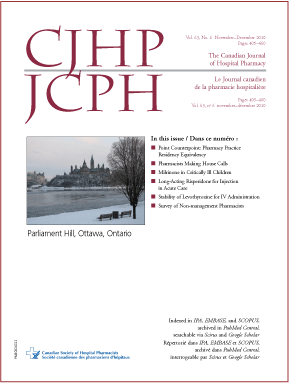Pharmacists Making House Calls:Innovative Role or Overkill?
DOI:
https://doi.org/10.4212/cjhp.v63i6.959Keywords:
pharmacist, home visit, resource utilization, pharmacien, visite à domicile, utilisation des ressourcesAbstract
Background: The Medication Management Program was established at the Fraser Health Authority in 2005, in response to evidence suggesting that having pharmacists provide care to patients in their homes after discharge from hospital could reduce subsequent utilization of health service resources.
Objective: To determine the effectiveness of the Medication Management Program in its first 2 years of operation.
Methods: For patients who had received a home visit by a pharmacist, the utilization of health services (admissions to hospital, physician office visits, and dispensed medications) in the year before the home visit was compared with utilization during the year after the intervention. The net cost of the program was also determined.
Results: In the first 2 years of the Medication Management Program (2005/2006 and 2006/2007), a total of 1171 patients received a home visit from a pharmacist. Of these, 836 (71%) were included in the before and-after analysis. The median per-patient cost for utilization of health services was $11 014 lower in the year after the intervention than in the year preceding the intervention. After the costs of the program were taken into account, this resulted in a net median cost reduction of $3047.43 per patient.
Conclusion: The Medication Management Program was effective as a clinical program in its first 2 years.
RÉSUMÉ
Contexte : Le Programme de gestion des médicaments a été mis en oeuvre en 2005 à la Fraser Health Authority en Colombie-Britannique, à la lumière de données suggérant que des soins à domicile prodigies par des pharmaciens à des patients après leur congé de l'hôpital pourraient réduire l'utilisation subséquente des ressources en soins de santé.
Objectif : Déterminer l'efficacité du Programme de gestion des médicaments dans les deux premières années de son existence.
Méthodes :On a comparé l'utilisation de services de santé (hospitalisations, consultations médicales et médicaments délivrés) de patients ayant reçu des soins à domicile par un pharmacien dans l'année précédant la visite du pharmacien à domicile à l'utilisation de ces ressources dans l'année suivant l'intervention. On a également calculé le coût net du programme.
Résultats : Dans les deux premières années du Programme de gestion des médicaments (2005-2006 et 2006-2007), un total de 1171 patients ont reçu une visite à domicile d'un pharmacien. De ces patients, 836 (71 %) ont été inclus dans l'analyse pré- et post-intervention. Le coût médian par patient de l'utilisation des services de santé était inférieur de 11 014 $ dans l'année suivant l'intervention, comparativement à l'année précédant l'intervention. Après avoir tenu compte du coût du programme, la réduction du coût net median était de 3047,43 $ par patient.
Conclusion : Le Programme de gestion des médicaments s'est avéré efficace comme intervention clinique dans ses deux premières années.Downloads
Downloads
Issue
Section
License
Copyright © Canadian Society of Healthcare-Systems Pharmacy.
After publication of a manuscript in the CJHP, the authors of the manuscript must obtain written permission from the CSHP (publications@cshp.ca) before reproducing any text, figures, tables, or illustrations from the work in future works of their own. If a submitted manuscript is declined for publication in the CJHP, all said rights shall revert to the authors. Please note that any forms (e.g., preprinted orders and patient intake forms) used by a specific hospital or other health care facility and included as illustrative material with a manuscript are exempt from this copyright transfer. The CJHP will require a letter from the hospital or health care facility granting permission to publish the document(s).










